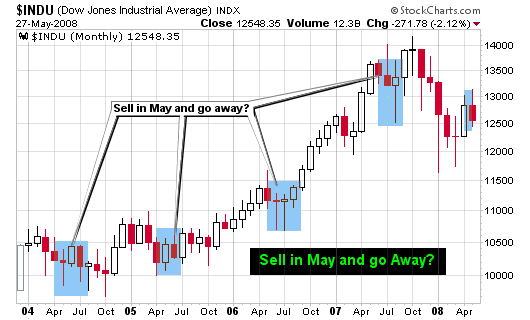It’s that time of year again, “Sell in May and Go Away”, so I will upload up my annual post of statistics using the help of the Stock Trader’s Almanac written by Jeffery A. Hirsch and Yale Hirsch.

For the record, I don’t sell just because the calendar says May but I do enjoy sharring the statistical data (it is very interesting):
Worst six months of the year begin in May:
* All data is from the DJIA from 1950 to 2005
- A $10,000 investment in the DJIA compounded to $544,323 for the period beginning in November through April over the past 56 years (termed the best six months)
- Compare this to a $272 loss; yes I said loss for the same investment in May through October (termed the worst six months)
- 44 of the 56 periods ended with a gain in the November through April period
- Only 33 periods ended with a gain versus 23 losing periods in May through October
- The average gain for the November through April period is 7.9% (56 yrs)
- The average gain for May through October is 0.3% but the period did have an overall loss of $272 as mentioned above
- The best six months gained 11,691.79 Dow points over the 56 yrs (data ends in 2005)
- The worst six months actually lost 538.98 Dow points
- Top performing period for best six months was a gain of 29.8% in 1985 and then 25.6% in 1998
- Top performing period for worst six months was a gain of 19.2% in 1958 and then 16.9% in 1982
- The poorest performing period for the best six months was a loss of 14.0% in 1969 and then 12.5% in 1973
- The poorest performing period for the worst six months was a loss of 25.2% in 2002 and then 22.4% in 1974
- The best six months has only had one losing period in the past 22 years and that was only 2.2%
- The worst six months has had eight losing periods over the past 22 years with several in double digits
- Seven of the past eight years have been losers for the worst six months
- All of these results are based without timing the market using technical analysis
- Using a simple MACD indicator to time the entries and exits, the gain during the best six months rises up to $1,548,121 while the loss during the worst six months increases to $6,646.
- Finally, five of the last nine May months have been down for the markets; starting the period of the “worst six months”
One side note: the Stock Trader’s Almanac notes that the Nasdaq actually has a best eight month period from November to June.
For further detail, grab a copy of the Almanac as I buy one every year for the excellent statitical information and the great quotes.
For all CP sell articles, visit my category on selling or short selling!





Are you sure that these statistics are right? I mean a 544323% gain compared to a .03% loss seems quite stunning.
“Seven of the past eight years have been losers for the worst six months”.
Just look at the Chart above, the worst months of 05 and 06 were both winners.
Please excuse me if I misinterpretated anything.
alot of talk around the stock world about the simple ‘sell in may go away’ amazing how there are stats to back such a strat. I wonder how a backtest would run on the ‘sell in may’ theory would work during times the indicies were trading below their 200ema
Thomas,
Re-read the stats – they are dollar gains, not percentage and yes they are 100% accurate. Pick up a copy of the almanac (any year you wish).
Cire,
They are amazing stats – I first read about them when I bought my first stock almanac several years back.
Thanks for this great information. Too many times traders ignore these facts and find themselves on the wrong side of the market.